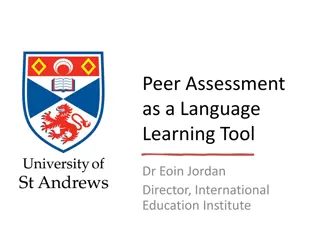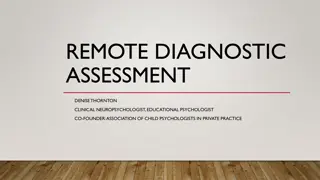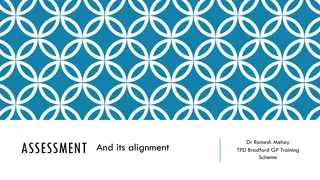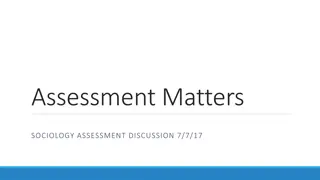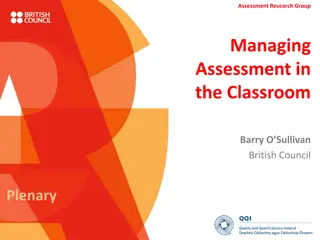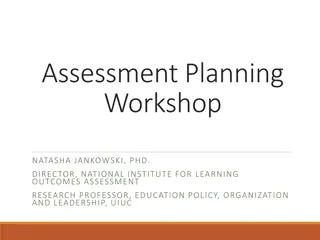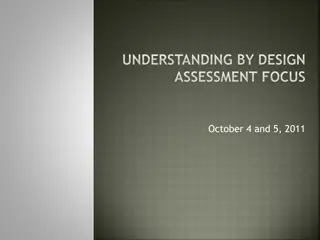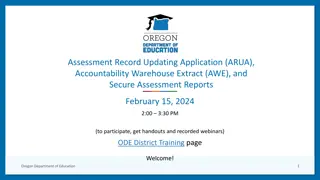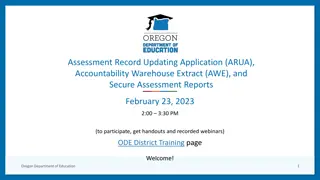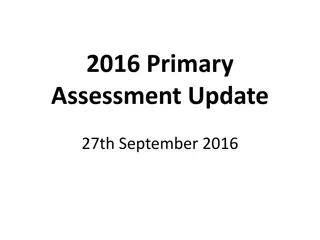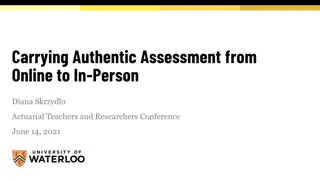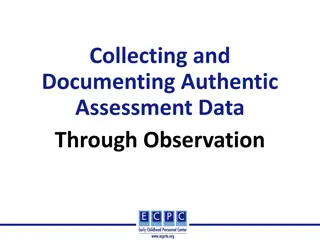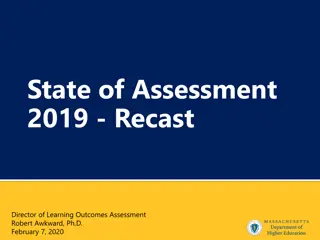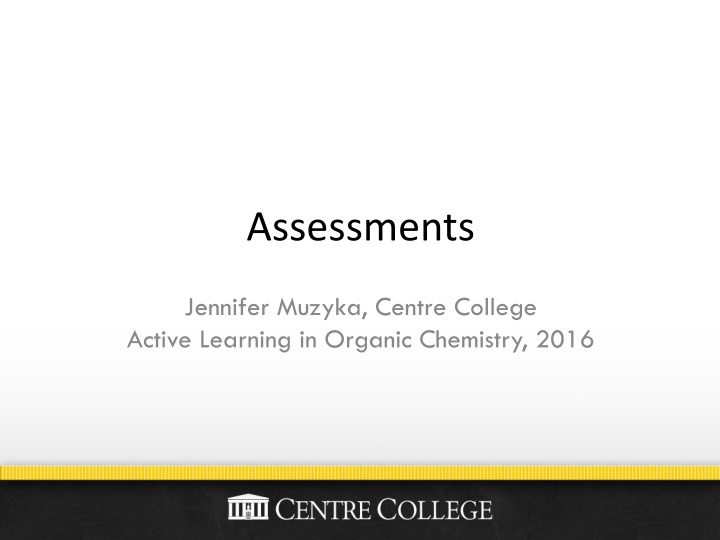
Purpose and Challenges of Assessment in Education
Explore the significance of assessment in education, its diverse purposes, common problems, and the distinction between reliability and validity. Discover how summative and formative assessments play key roles in student learning and instructional improvement.
Download Presentation

Please find below an Image/Link to download the presentation.
The content on the website is provided AS IS for your information and personal use only. It may not be sold, licensed, or shared on other websites without obtaining consent from the author. If you encounter any issues during the download, it is possible that the publisher has removed the file from their server.
You are allowed to download the files provided on this website for personal or commercial use, subject to the condition that they are used lawfully. All files are the property of their respective owners.
The content on the website is provided AS IS for your information and personal use only. It may not be sold, licensed, or shared on other websites without obtaining consent from the author.
E N D
Presentation Transcript
Assessments Jennifer Muzyka, Centre College Active Learning in Organic Chemistry, 2016
Whats the purpose of assessment? Rate students Rate professor & course Motivate students to keep up Feedback to students about learning Feedback to instructor about student learning Provide instructional accountability Improve teaching and learning
Problems with assessment Students don t retain what they learned Test questions not like real life problems Instructor conflict (coach vs. judge) Grades reduce student motivation to learn
Problems with assessment Reliability vs. validity Reliability does the test consistently rank order students Validity is the test measuring what it intends to measure Problem many of us focus on reliability and neglect validity What are we measuring and why?
Summative Assessment Tests Quizzes Papers Presentations Grades are not an effective motivator for learning
Formative Assessment Clickers Nearpod Reading questions In-class activities Formative assessment helps weaker students the most
Formative Assessment Formative assessment ferrets out misconceptions and brings them into working memory to address them.
Alignment Course goals In-class activities Summative assessment Time spent indicates relative importance Backward design Learning objectives
Criteria / Evidence of learning What student behavior indicates understanding Criteria for different levels of understanding Rubrics!
Rev. 2/25/2009 CHE 241 Laboratory Report Rubric, Spring 2009 Distinguished Includes a concise statement of the problem as well as a plan for how to solve it. Relevant references are correctly cited. All reactions are clearly drawn using structures main reaction and side reactions. Mechanism(s) provided. All starting materials, reagents, and products appear in table with all relevant amounts and physical properties. Concentration information included for solutions. Theoretical yield calculation is correct and neatly labeled. Experimental Plan Proficient Minor grammatical errors in statement of problem and/or minor citation errors. Incomplete citation. Reactions are messy or minor error appears. Used molecular formulas instead of structures. One or two physical properties are missing from table, or table is slightly messy. Apprentice One part of experimental plan missing or there are significant errors in plan. Absent citation One significant error in reaction. Mechanism or side reaction(s) missing. Reaction Summary (when appropriate) Table of Reagents and Products Data are not presented in table format. One or two compounds are missing from table, or several physical properties are missing. Minor error in theoretical yield calculation, or calculation is messy. Most steps are correctly shown in diagram, with only minor errors about what steps accomplish. More than one error in calculation. Calculation of Theoretical Yield Flow Diagram Includes all procedures to be followed, with reasonable understanding demonstrated for the purpose of each step. Uses skeletal structures for compounds. Appropriate detail of observations, with all masses, volumes, and relevant information recorded. Easy to follow. Product is described fully appearance, mass, and physical properties. Properties of product are compared to literature values. When appropriate, percent yield or other well labeled calculations are provided. Conclusions are reasonable based on correct interpretation of data. The section is well written, with no grammatical errors. Proposes ways to improve experiment next time. Typed pages are double spaced. Report is in correct order and is stapled. Significant errors about what steps accomplish, or multiple steps missing from diagram. Inadequate observations, but all relevant data recorded. Slightly difficult to follow. Observations irrelevant and/or data difficult to locate in lab notebook. Data and Observations Product description is incomplete. Product properties are not compared to literature values. Yield Data The section has minor grammatical and/or spelling errors. Conclusions are not adequately justified by the data. Data are incorrectly interpreted and/or conclusions are not relevant based on the data obtained in the experiment. Discussion and Conclusions Typed pages are single spaced. Report is out of order and/or not stapled. Common misspelled words: vial, separate, perform This used without referring to a noun The section has minor grammatical and/or spelling errors. Report not submitted to turnitin.com General The section is well written, with no grammatical errors. Exercises The answers are not written in complete sentences and/or provide incorrect chemical information.
CHE? 500? Oral? presentation? rubric,? Spring? 2015? Component? Understanding? Sophisticated? (10)? Shows? a? deep/robust? understanding? of? the? topic? with? a? fully? developed? argument.? All? chemical? concepts? are? explained? correctly? and? with? reasonable? detail.? Slides? are? error-free? and? logically? present? the? main? issues.? ? Material? is? readable? and? graphics? highlight? and? support? main? ideas.? Competent? (8)? Shows? an? understanding? of? the? topic,? but? not? quite? a? fully? developed? argument.? A? few? small? errors? in? explanations.? Developing? (6)? Shows? a? superficial? understanding? of? the? topic,? argument? not? developed? enough.? Numerous? small? errors? or? one? significant? error? in? explanations.? Not? Competent? (4)? Shows? no? understanding? of? the? material.? Chemistry? Multiple? significant? errors? in? explanations.? Visual? Aids? Slides? are? error? free? and? logically? present? the? main? issues.? ? Material? is? mostly? readable? and? graphics? reiterate? the? main? ideas.? ? There? are? not? enough? graphics? and? too? many? words? on? the? slides.? Speaker? is? mostly? audible? and? fluent? on? the? topic,? and? requires? minimal? referral? to? notes.? ? Speaker? responds? to? most? questions? accurately? and? appropriately.? Slides? contain? errors? and? lack? a? logical? progression.? ? Major? aspects? of? topic? are? absent.? ? Diagrams? or? graphics? are? absent.? ? Slides? confuse? the? audience.? Errors? or? missing? graphics? on? most? slides? make? it? difficult? to? follow? the? presentation.? ? There? are? full? sentences? on? the? slides.? Oral? presentation? Speaker? displays? enthusiasm,? is? audible? and? fluent? on? topic,? and? does? not? rely? on? notes? to? present? or? respond.? ? Speaker? responds? accurately? and? appropriately? to? audience? questions? and? comments? Demonstrates? a? high? level? of? comfort? and? connection? with? audience? by? using? appropriate? and? meaning? gestures? and? eye? contact? with? audience.? Speaker? is? often? inaudible? or? hesitant,? often? speaking? in? incomplete? sentences.? ? Speaker? relies? heavily? on? notes.? ? Speaker? has? difficulty? responding? clearly? and? accurately? to? audience? questions.? Speaker? reads? from? the? slides? and/or? notes.? ? Speaker? is? unable? to? answer? questions? or? provides? answers? that? are? incorrect.? Body? language? Demonstrates? a? slight? discomfort? with? audience? by? a? slight? tendency? to? repetitive? and? distracting? gestures? (e.g.,? tapping? a? pen,? wringing? hands,? etc.)? and? breaking? eye? contact? with? audience.? Central? idea? and? theme.? ? Effective? presentation? strategy.? Demonstrates? a? high? degree? of? discomfort? interacting? with? audience? by? frequent,? repetitive,? and? distracting? gestures,? little? audience? eye? contact,? and/or? stiff? posture? and? movement.? Demonstrates? severe? discomfort? with? audience,? having? no? eye? contact? and? distracting? gestures.? Organization? Clear? and? compelling? presentation.? ? Focused,? with? sophisticated? presentation? strategy.? Develops? basic? idea? or? theme.? ? Rudimentary? presentation? strategy.? Misses? central? idea? or? theme.? ? Meandering? with? no? apparent? presentation? strategy.? ?
Misconceptions How do we become aware of them? How do we address them, to help students develop more mature knowledge?
Assessment tools Assessment tools resemble active learning activities & accomplish similar goals
Assessment tools Ask WHY a lot! Nearpod Moodle EasyOChem YouTube Group quizzes Group exam questions Homework? Scoring guides
Resources Scientific Teaching by Jo Handelsman, Sarah Miller, Christine Pfund, W.H. Freeman, 2007. Introduction to Rubrics by Dannelle D. Stevens and Antonia J. Levi, Stylus, 2005. Classroom Assessment Techniques: A Handbook for College Teachers by Thomas A. Angelo and K. Patricia Cross, Jossey-Bass, 1993. From Degrading to De-Grading, by Alfie Kohn, High School Magazine, March 1999. Punished by Rewards: The Trouble with Gold Stars, Incentive Plans, A s, Praise and Other Bribes, by Alfie Kohn, Houghton Mifflin, 1999. Inside the Black Box: Raising Standards through Classroom Assessment, Paul Black and Dylan Wiliam, Phi Delta Kappan, September 2010, 92 (1) 81-90. Assessment and Classroom Learning, by Paul Black and Dylan Wiliam, Assessment in Education, March 1998, 7-74.


